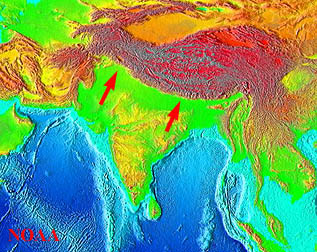|
Continent/continent convergence
 When
two continents collide after the entire ocean floor which separated them
has been subducted, their deformed leading edges meet and one of the continents
will begin to slide underneath the other, leading to a thickened lithosphere.
This process is called underplating. The resultant collision creates
a giant internal mountain range whose position marks the seam along
which the original continental masses have been joined. Because these mountains
represent the compressed welded edges of continents, the lithosphere is
thickened, preventing magma from rising to the surface; as a consequence,
such a boundary only rarely exhibits volcanism. However, the forces which
deform these continents create enormous stresses which are released as
earthquakes.
Because these events involve non-subducting lithosphere, they are of the
shallow
and intermediate focus type. The Himalayas mark such a plate junction
which is still active, where India is underplating Asia. The Urals delineate
where Asia and Europe collided, and the Appalachians mark the edge of a
large supercontinent which was originally formed by the collision between
Eurasia and North America, and has subsequently pulled apart again. When
two continents collide after the entire ocean floor which separated them
has been subducted, their deformed leading edges meet and one of the continents
will begin to slide underneath the other, leading to a thickened lithosphere.
This process is called underplating. The resultant collision creates
a giant internal mountain range whose position marks the seam along
which the original continental masses have been joined. Because these mountains
represent the compressed welded edges of continents, the lithosphere is
thickened, preventing magma from rising to the surface; as a consequence,
such a boundary only rarely exhibits volcanism. However, the forces which
deform these continents create enormous stresses which are released as
earthquakes.
Because these events involve non-subducting lithosphere, they are of the
shallow
and intermediate focus type. The Himalayas mark such a plate junction
which is still active, where India is underplating Asia. The Urals delineate
where Asia and Europe collided, and the Appalachians mark the edge of a
large supercontinent which was originally formed by the collision between
Eurasia and North America, and has subsequently pulled apart again.
|

